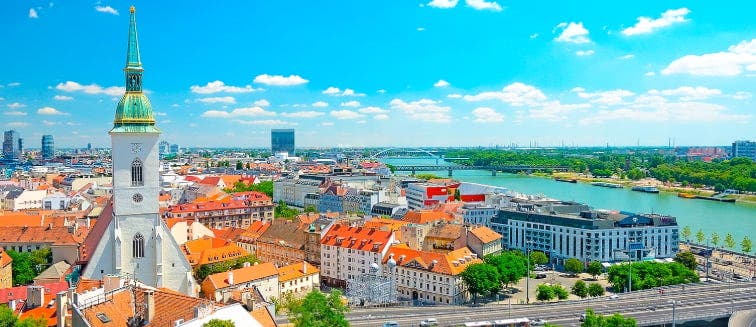A Central European nation known for its stretching mountain ranges and folk traditions, Slovakia is situated in the heart of Europe. Since the split of Czechoslovakia, Slovakia has emerged as its own unique, prosperous and abundant nation which attracts huge numbers of travellers every year with its beautiful countryside landscapes, towering Carpathian mountains and charming cities. The capital, Bratislava is famed for its food and drinks scene where party-goers can choose from a countless number of taverns to indulge in some of the fine local beers and wines. Outside of the capital, nature prevails in the lakes, rolling valleys and the snow-topped Tatra Mountains. Also, a number of smaller cities, such as Kosice, provide charming insights into authentic Slovakian life. A holiday to Slovakia is often incorporated into larger tours of Europe as its location between Austria, Ukraine, Czech Republic, Poland and Hungary, make it convenient to include on a multi-centre tour. Its compact size allows visitors to easily experience the different sides of the country in one trip. Despite its small size, a tour of Slovakia is sure to tick all the boxes: medieval cities, picture-perfect countryside, outdoor activities and great nightlife.
History of Slovakia
Slovakia has no lack of historic monuments and great folkloric tales that document its diverse past. The Slavs first arrived in Slovakia in the 5th and 6th centuries, forming part of the short-lived, yet huge tribal union of the Samo’s Empire in the 7th century. The first major West Slavic state of Central Europe emerged in Slovakia in the 10th-century, the Empire of Great Moravia, but was soon absorbed into the Kingdom of Hungary. You can explore the history and experience the splendour of this time at Spis Castle, the largest castle in Central Europe, still standing today in the east of the country. Slovakia suffered at the hands of the Mongol Invasion which swept eastern and central Europe in the 13th-century. Later, German settlers began settling in the region, which explains the influences of Germanic culture that you can observe on a trip to Slovakia. Following the First World War and the dissolution of the Austro-Hungarian empire, the union of Czechoslovakia was formed. This union endured until 1993, having been a communist state and part of the Soviet-led Eastern Bloc. The peaceful dissolution of the union into two separate countries brought Slovakia independence and it has been fostering its own identity and nation ever since.
Nature in Slovakia
The natural beauty of Slovakia cannot be underplayed, for the Carpathian Mountains, which stretch across much of the north of the country, are filled with unbelievably picturesque formations, views and peaks. An impressive 41% of the country is covered in forest and there are 9 national parks to protect many of the most beautiful parts of the country. A tour of Slovakia is incomplete without contemplating the Tatras, the highest part of the Carpathian range, perfect for skiing and hiking. Mount Krivan is the most famous mountain in the country, famed for its perfect snow-topped peak. Slovakia is also known for its immense cave systems, some of which are designated UNESCO World Heritage Sites such as the Dobsinska Ice Cave the Gombasek Cave and the Jasovska Cave. The Danube Lowlands, in the south of the country, is in stark contrast to the mountainous north, with lush green landscapes and rich agricultural lands along the fertile banks of the River Danube. With outdoor activities ranging from hiking in the aptly named Slovak Paradise National Park, a haven of waterfalls, lakes and forests, to skiing in Jasna, Slovakia has enough nature for all travellers to enjoy.
Culture in Slovakia
Like many Central European countries, Slovakian culture is the product of a number of regional influences, many of which come from its geographical neighbours. Folk traditions are a cornerstone of the national culture, manifested in music, dance, literature and the arts, and kept alive by the Slovak Folk Art Collective, who represent the country in the annual folklore festival, held in the village of Východná and the largest and oldest celebration of folklore in Europe. Many unique and wonderful traditions have been successfully preserved in the country and are a source of national pride. Whilst on holiday in Slovakia it is recommended to enjoy the local wine, as Slovakia produces fantastic wines in the vineyards of its southern regions. The country is also known for its herbal teas, which you can sample in any number of traditional tea houses. Many Slovakians rely on different herbal teas to treat a number of common, everyday illnesses. Aside from folklore and national produce, Slovakia is known for its high standard of living, enjoyed by its modest population of 5.4 million. Approximately 90% of all Slovakian citizens own their own home.
From the steeples of the medieval churches of Bratislava to the peaks of the snow-capped Tatra Mountains, a trip to Slovakia is a journey through the history and culture of Central Europe and an unmissable experience for all travellers looking to explore an off-the-radar destination.

